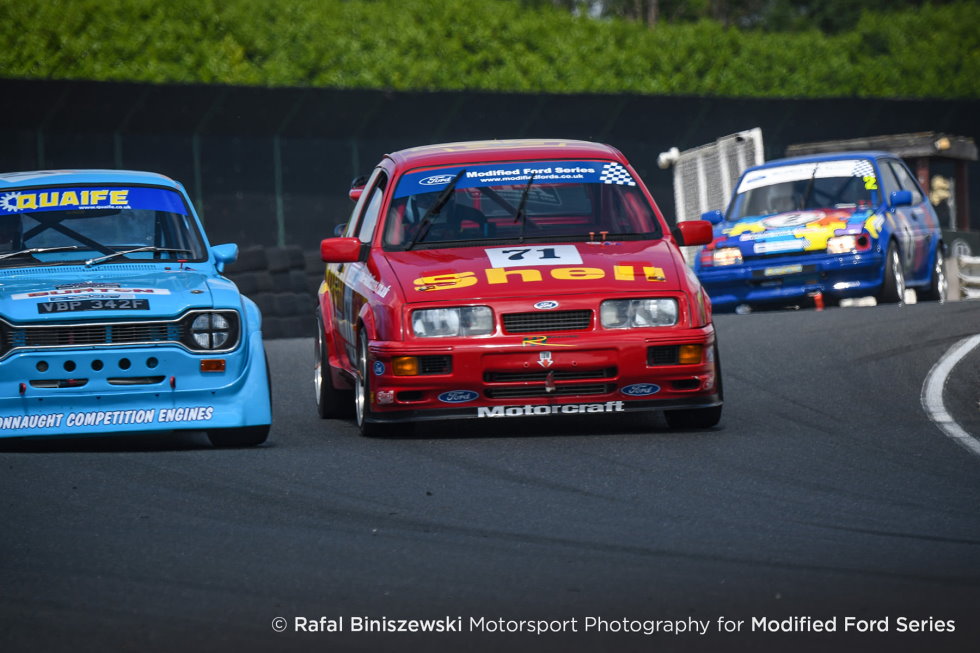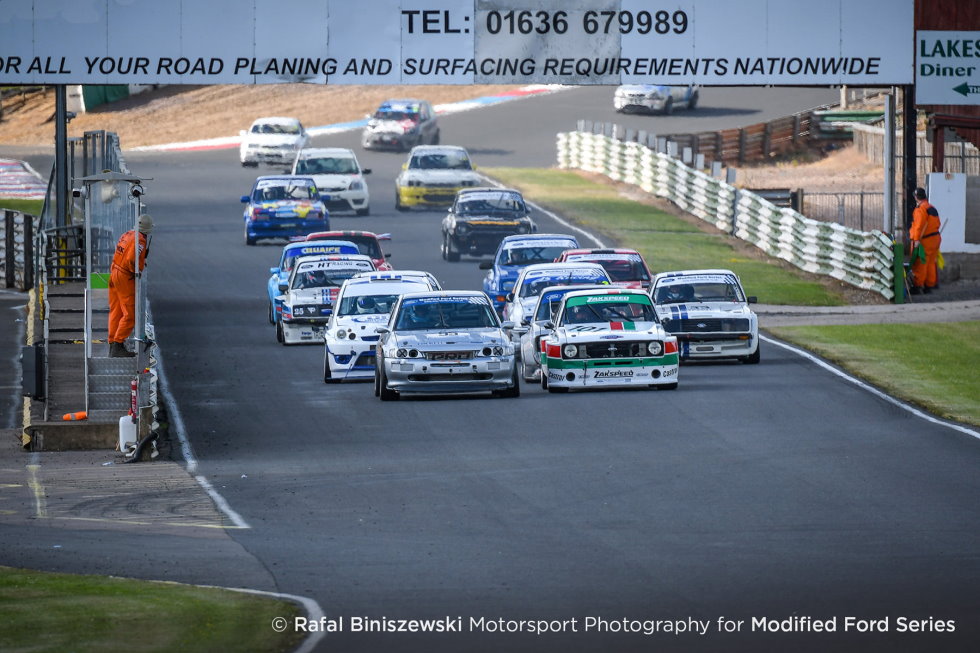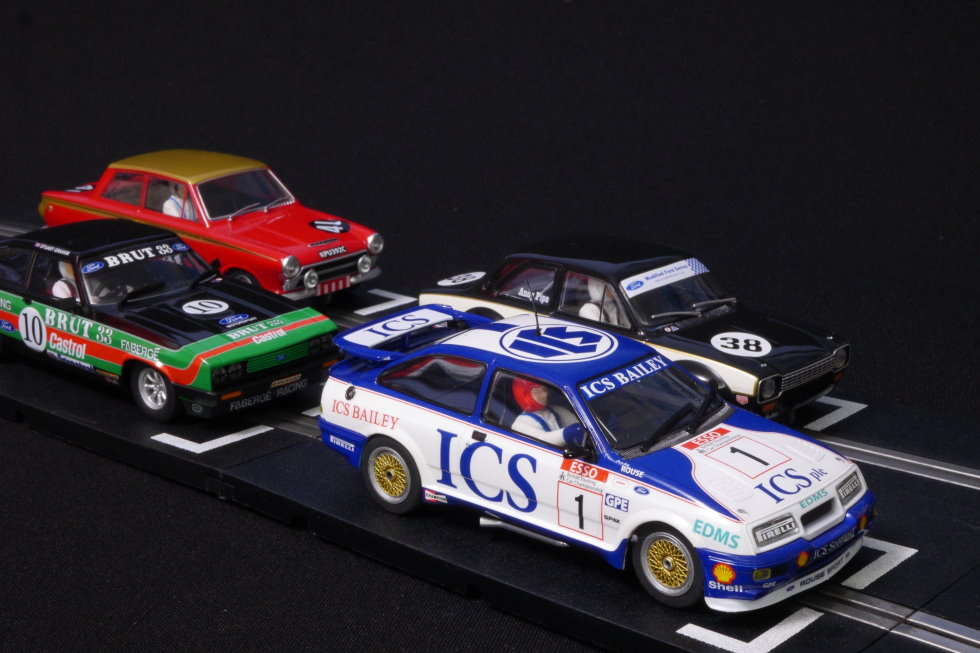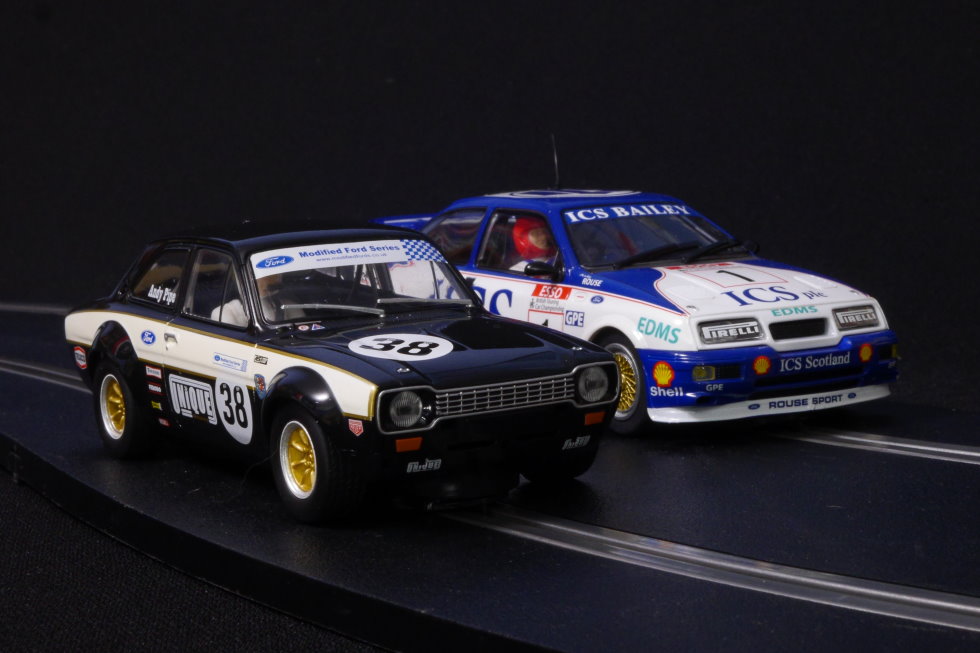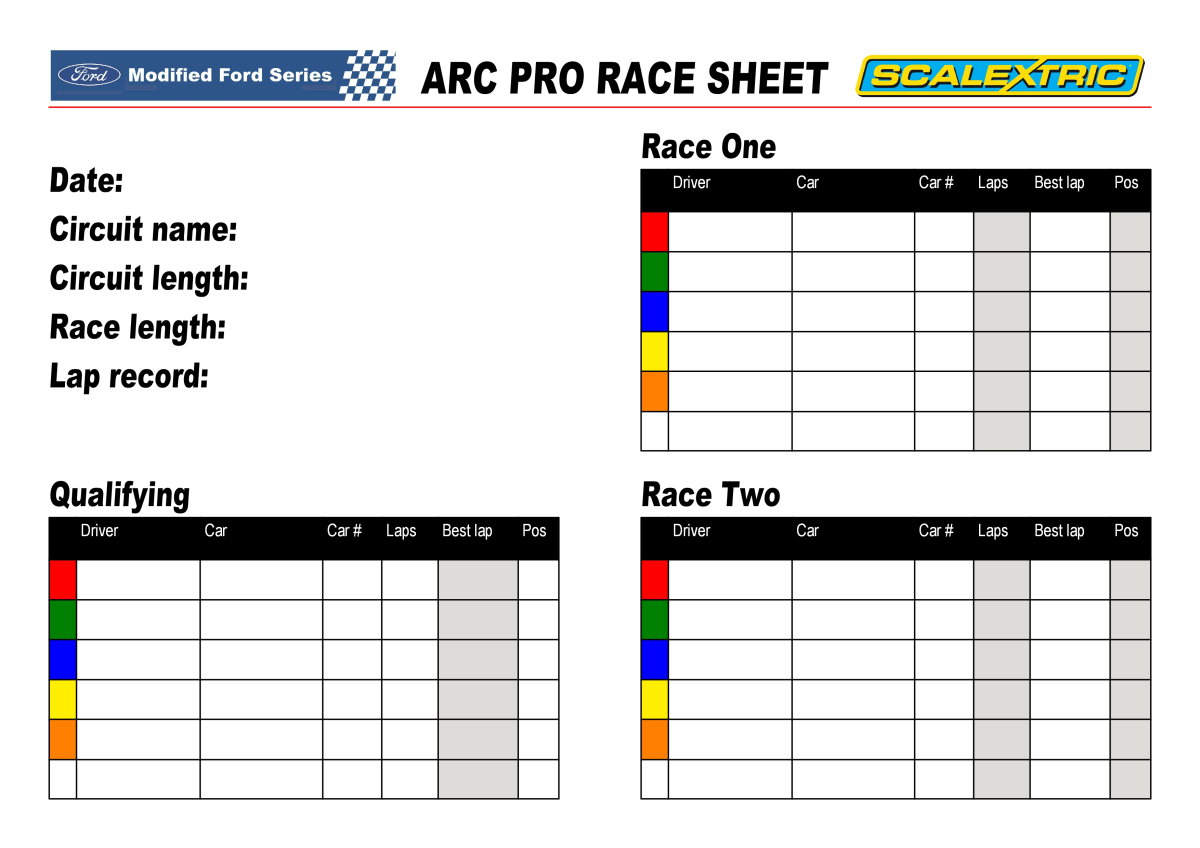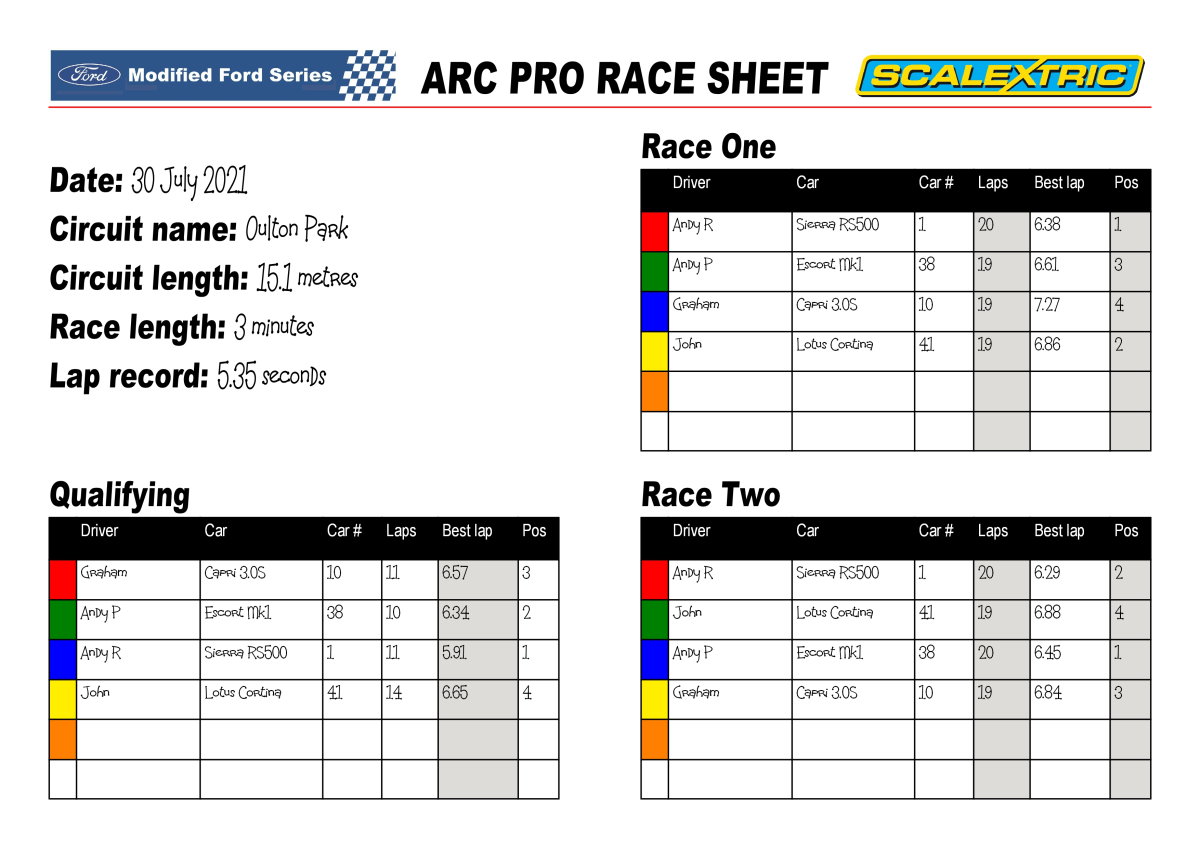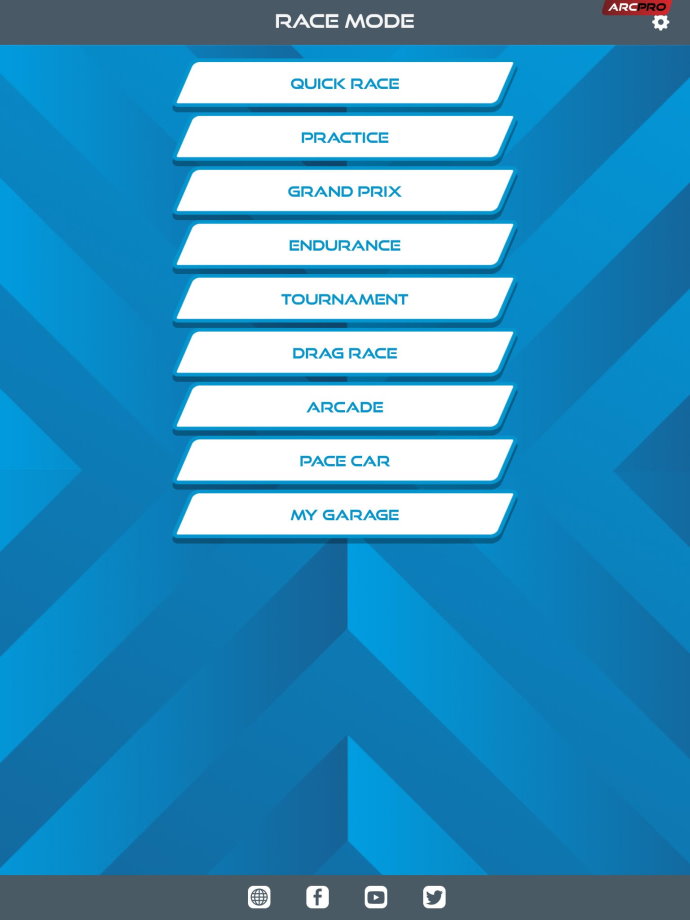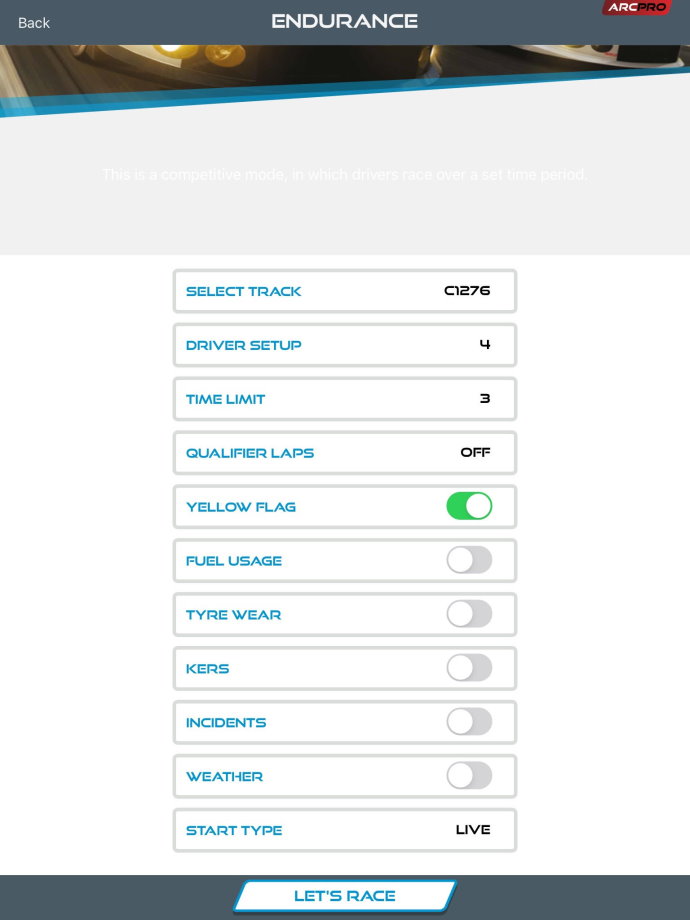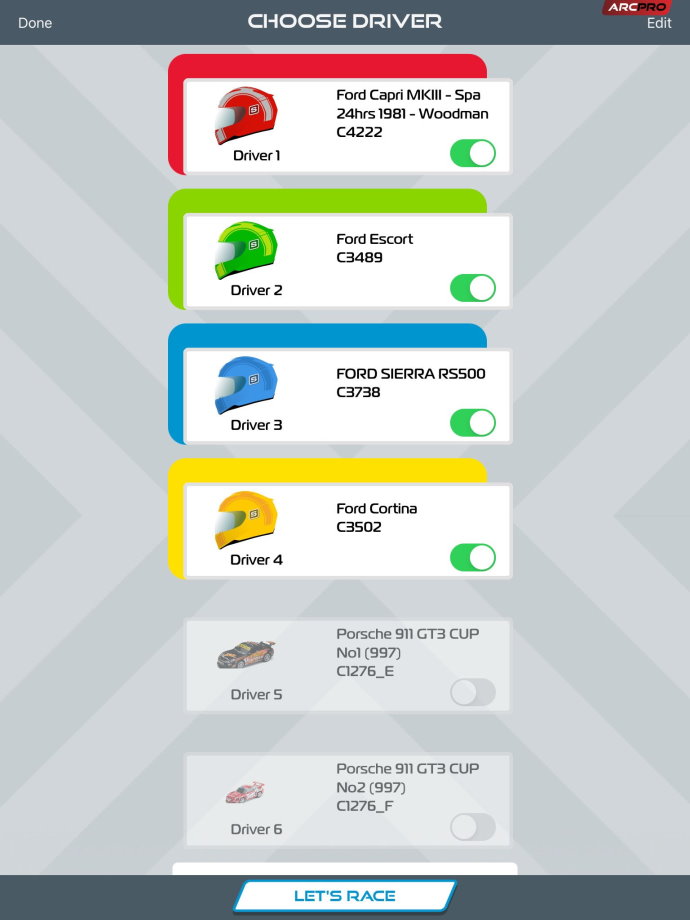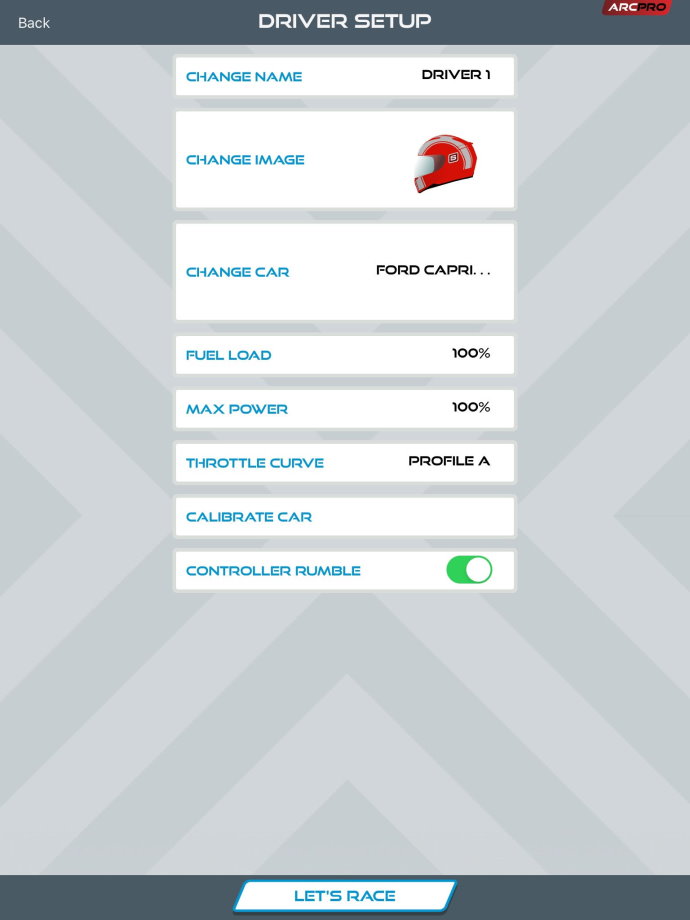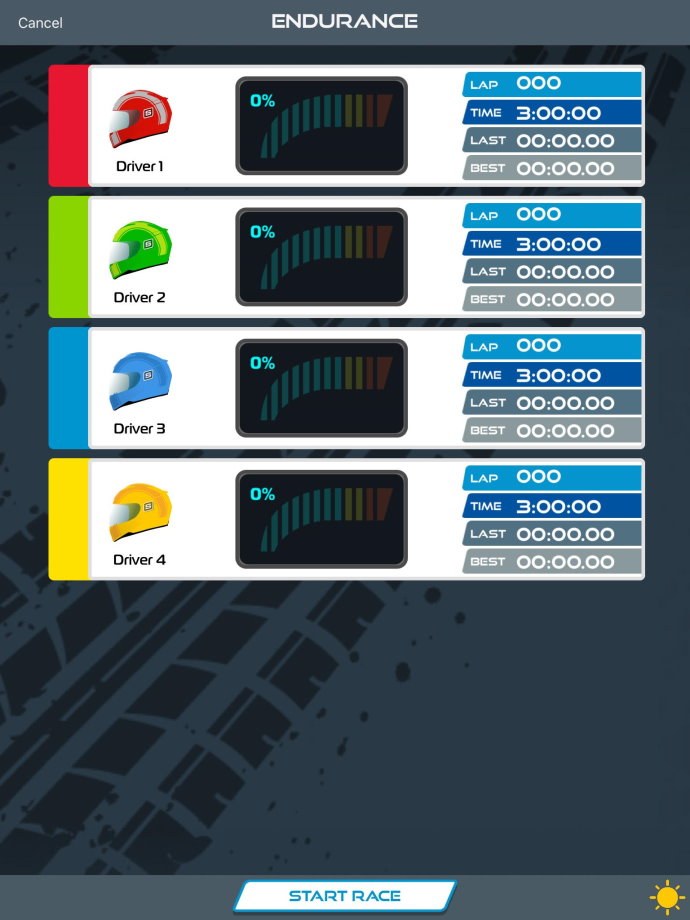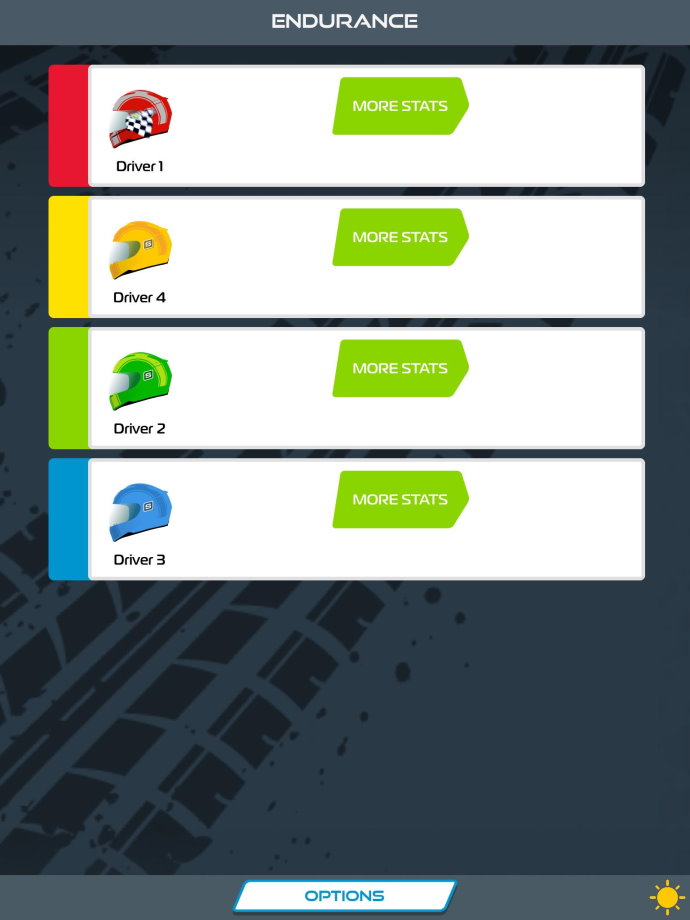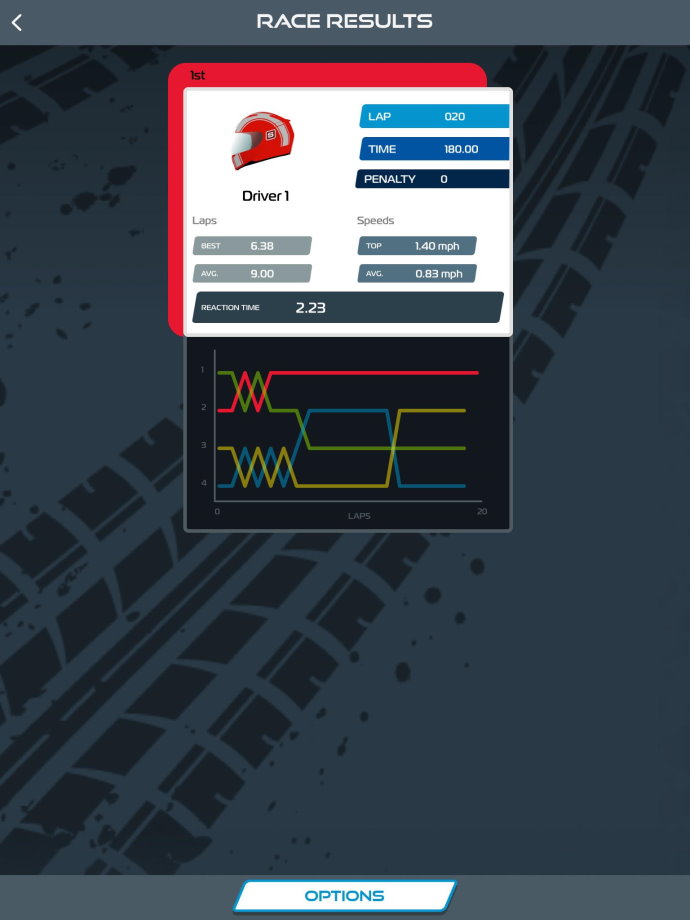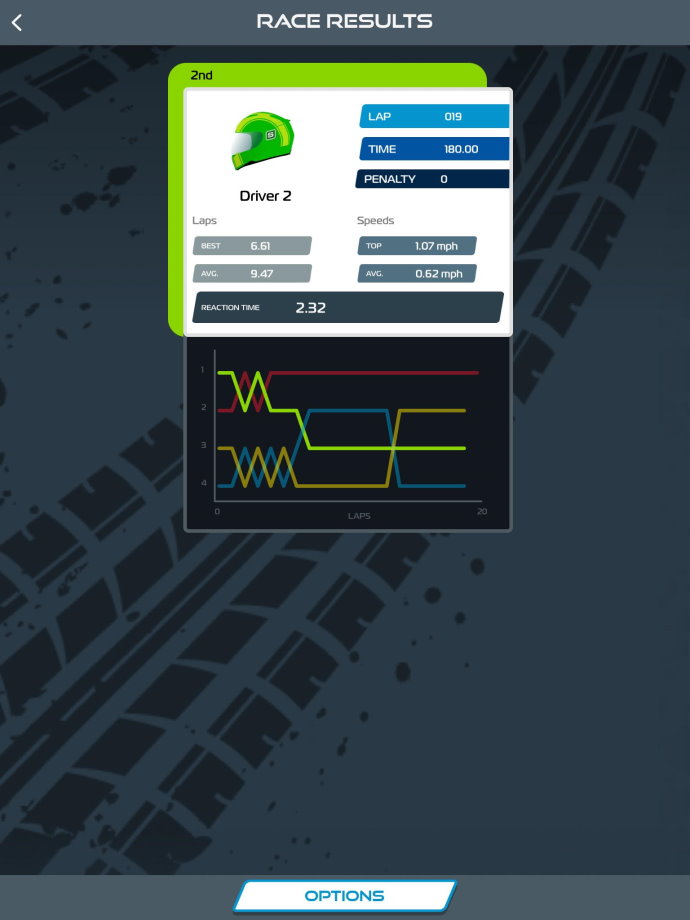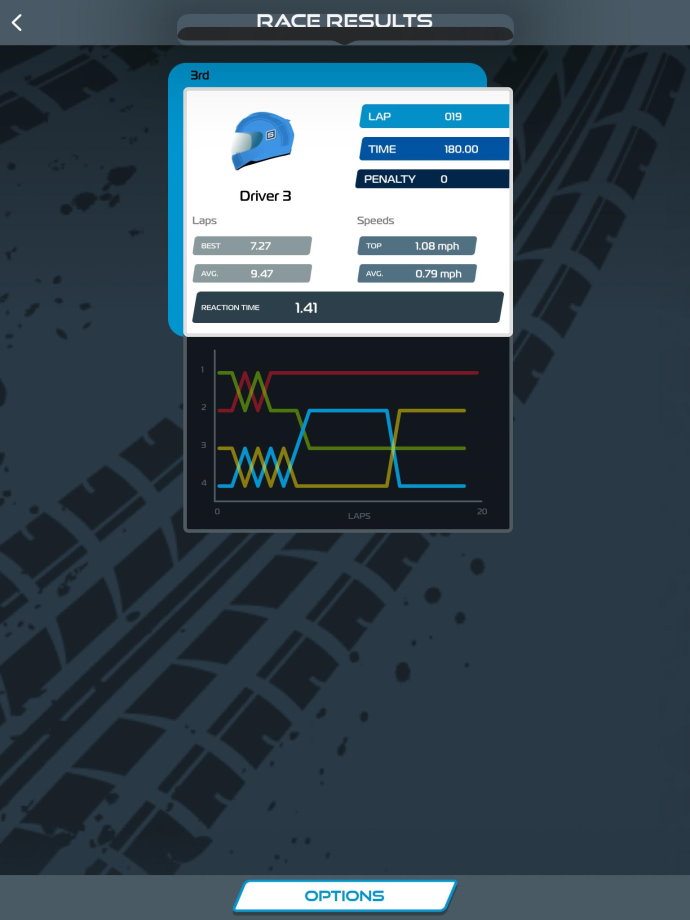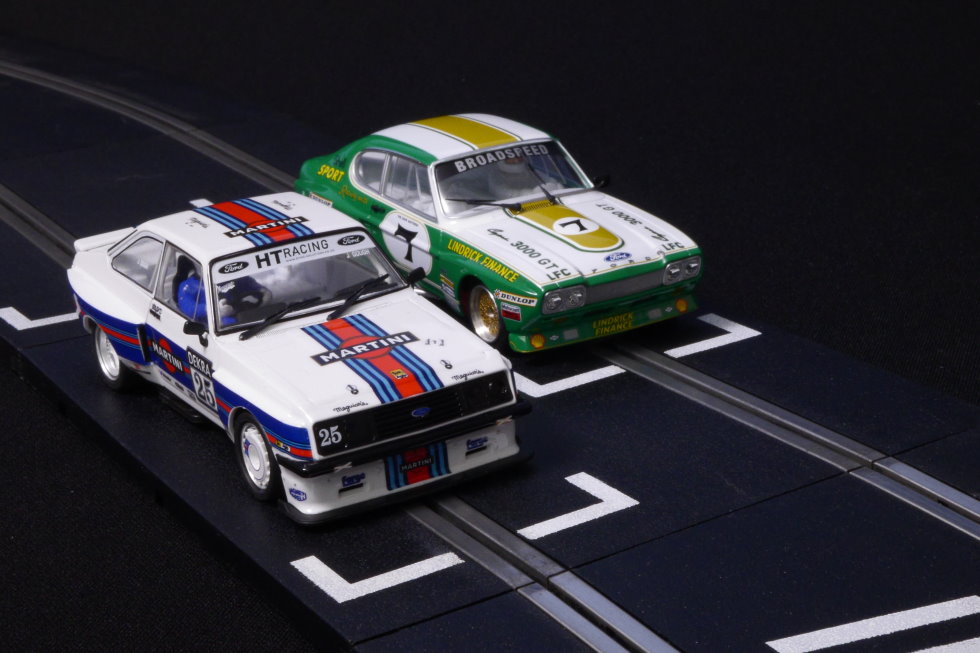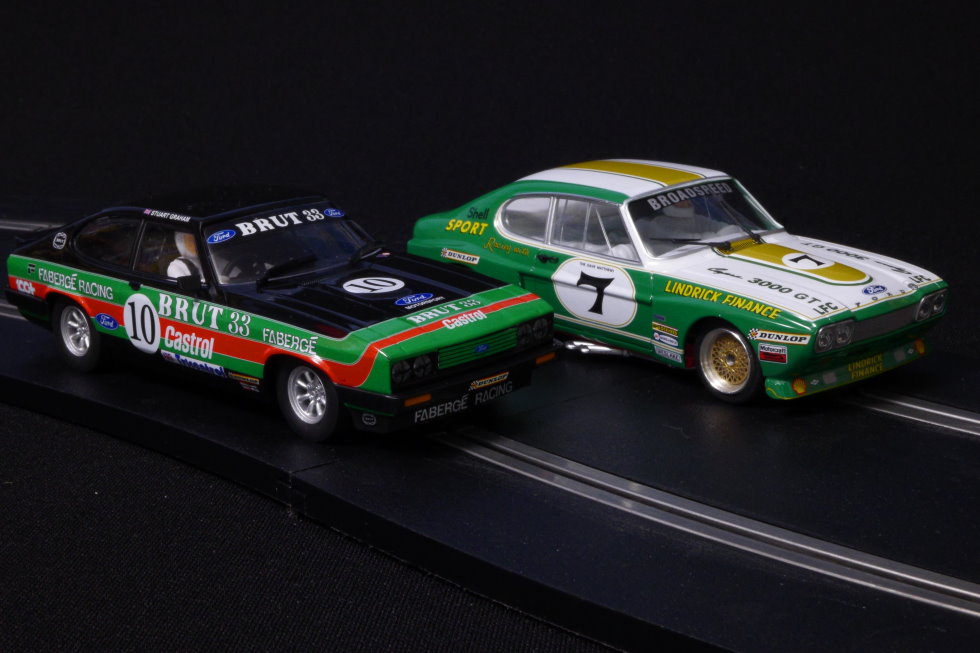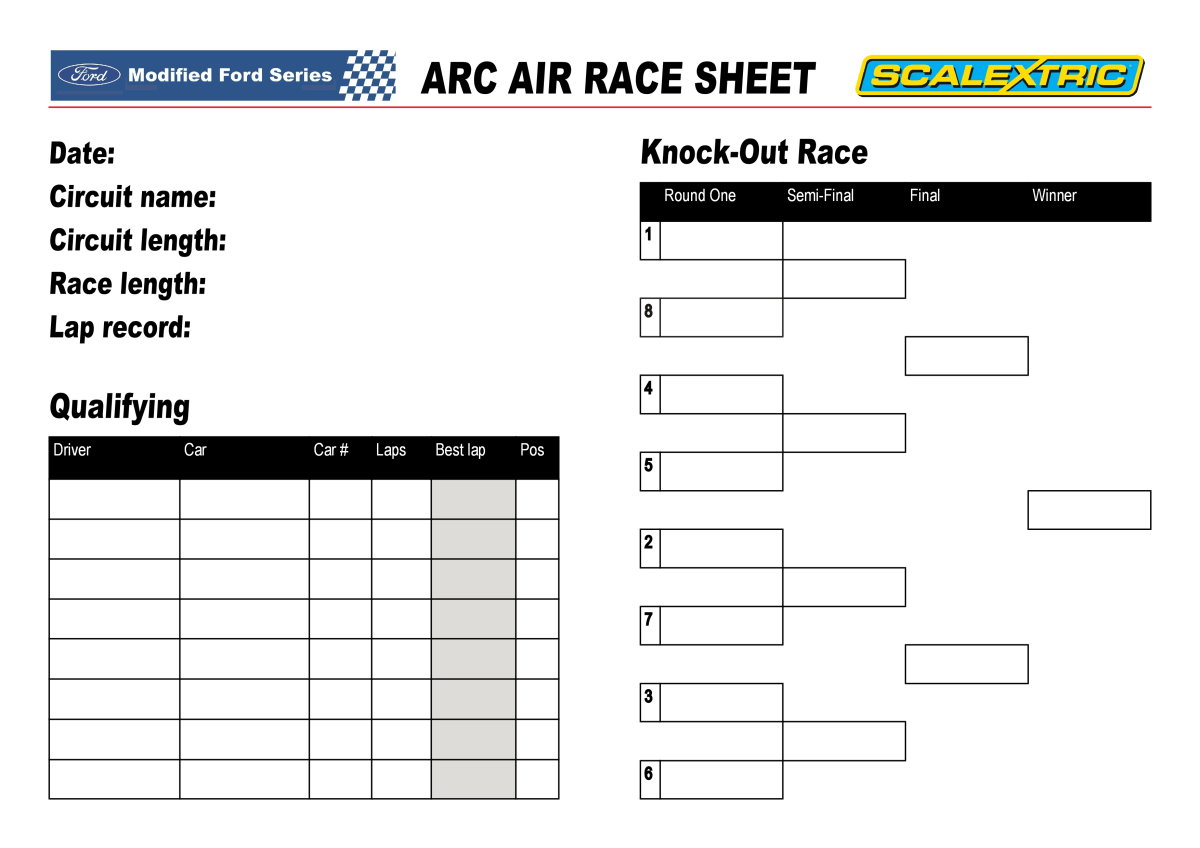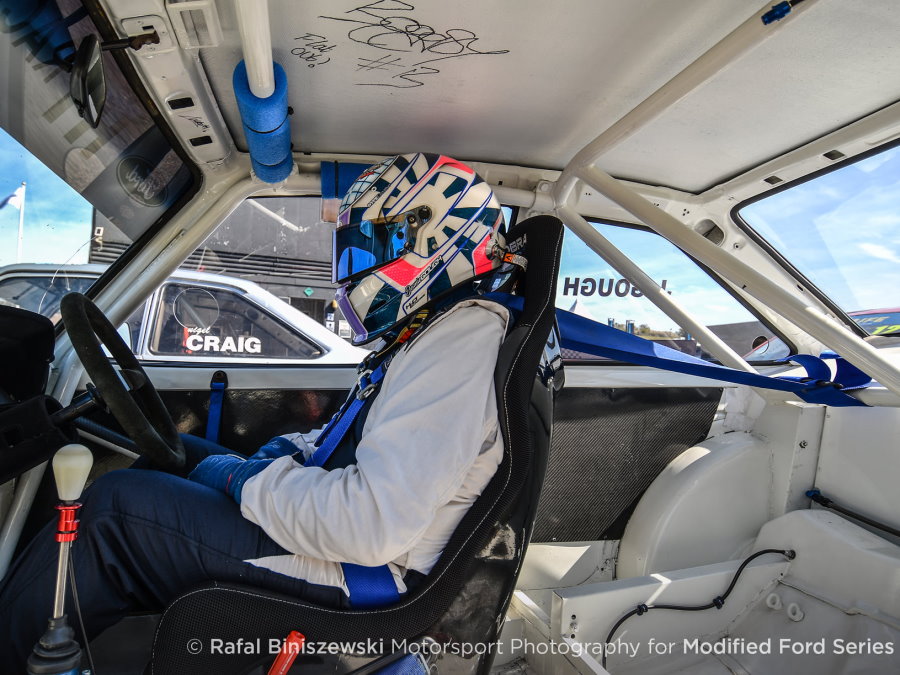Are you ready to rumble?
Andy Pipe’s Ford Escort is sadly out of action for a while – so it’s up to Scalextric fans to race 1:32 scale versions of the stunning black, cream and gold Mk1. Andy is member of the Modified Ford Series, which is sponsored by Scalextric this year. With a colourful grid of all the best European-made Fords, this growing band of grassroots racers travels to circuits across the UK, having a lot of fun and thrilling the public.
In this blog post, I’m going to take a quick look at the Modified Ford Series and then recreate a typical race day using the Scalextric ARC app. There’ll be a digital format and also an ARC Air version for those of you who prefer traditional one-car-per-lane ‘analogue’ racing.
If you haven’t read the other two posts in this series, I interviewed Andy Pipe on the blog two weeks ago and reviewed the Scalextric model of his Escort last weekend. Don’t forget, you can still buy your own model of Andy’s Mk1 here: www.jadlamracingmodels.com/scalextric-slot-car-c4237-ford-escort-mk1-andy-pipe-racing/ and the digital version here: www.jadlamracingmodels.com/scalextric-digital-slot-car-c4237-ford-escort-mk1-andy-pipe-racing/ – but don’t dilly-dally, they are selling fast!
The Real Modified Ford Series
Organised by the drivers themselves, the Modified Ford Series is just two years old. The new series has brought together a diverse grid of cars that look and sound spectacular. Most importantly, the drivers get to race their treasured Fords within a like-minded community. It’s all about fabulous fast Fords and honouring the legend of the RS marque. Despite the challenges of the Covid pandemic, the series has been a great success – an amazing sixty cars are expected at Brands Hatch in September.
Scalextric provide slot car goodies for the ‘Driver of the Day’ and end of season awards. It’s a relationship that works well for both parties – an iconic brand raises the profile of the series and Scalextric support grassroots racing without much outlay. The drivers love it – and I have it on good authority that more Scalextric models of Modified Ford Series cars are in the pipeline.
Any pre-2010 European-produced Ford can race – and there are few restrictions to how the cars can be modified. Classes are based on engine size – ranging from Pumas, Fiestas and 1.6 Escorts in Class C up to some very special cars in Class A. In this top class, you’ll see 5-litre V8s and 2-litre Turbos powering Sierras, Capris and all eras of Escort.
Andy Pipe’s Mk1 races in Class B, alongside another of the pin-up Escorts – Jamie Gough’s Martini-liveried RS2000. Both are fitted with 2.3-litre Pinto engines. A fourth class – B1 – sits just above in terms of engine sizes. You can see pictures of almost all the cars that have raced so far over at the series website: www.modifiedfords.co.uk
Recreating a Modified Ford Series Race Day with Scalextric
I’ve always had an annoying habit of watching real motor racing and thinking “how can I recreate that with Scalextric?” Now we have highly detailed race management systems like the Scalextric ARC app, the sky is the limit – it’s possible to have a stab at simulating almost any event or series.
The Modified Ford Series race day is quite straightforward – 15 minutes of qualifying in the morning and then two races, also of 15 minutes, in the afternoon. The grid for Race One is set by qualifying times and the Race Two grid is set by the finishing order of the first race. There are no scheduled pit stops and the race begins with a rolling start behind the pace car.
Of course, the Modified Fords are only part of the day’s schedule – they share the day with other series and championships. And these vary, depending on the event and the circuit they are racing at. In terms of our Scalextric event, we can choose anything we fancy as support races – or just stick to the Fords. At the recent Anglesey round, there were two ‘Fun Cup’ endurance races and plenty more short 15-minute sprints with Formula Fords, Super Karts, Mazda MX5s and so on.
Scalextric have produced a lot of suitable European Fords that we can race. In recent years, there are Lotus Cortinas, Mk1 and Mk2 Escorts, Mk3 Capris, Sierra RS500s and – at a push – the RS200 Group B rally car. The Fiesta RS WRC falls just the wrong side of the 2010 cut-off date. If you want to go retro-Scalextric, there’s event more to add to the list – XR2, XR3, Escort Cosworth, Sierra Cosworth, Mondeo and Focus. There’s other manufactures too – Carrera’s awesome Zakspeed Capri and RS3100; SRC’s Capri RS2600; and Teamslot’s Escort RS2000, X-Pack and Zakspeed to name but a few. See how many suitable Fords you can find on the Jadlams website: www.jadlamracingmodels.com/scalextric-slot/cars
The cars I’ll be setting up are out-of-the-box modern Scalextric models – which have similar performance and are easily converted to digital with the C8515 digital plug. However, the beauty of the real Modified Ford Series is the vast range of cars that can be entered into a race – and the various modifications they can have. We can do the same with Scalextric. Faster cars can be put into the top class and slower ones into classes B and C. That way, the choice is vast, everyone has fun and there are up to three winners each time.
In terms of the tracks to race on, the Modified Ford Series will race at Lydden Hill, Donington, Mallory Park, Anglesey, Cadwell Park, Oulton Park, Brands Hatch and Snetterton this year. It’s always fun to race on different tracks – different cars might do better on one layout rather than another. There are lots of Scalextric track plans available – I particularly like the resources at SlotRacer Online, with all the BTCC circuits included here and the legendary ‘Scalextric 101 Circuits’ booklet reproduced here. Naturally, Jadlams will have any track pieces you need: www.jadlamracingmodels.com/scalextric-slot/track
With the cars and track sorted out, lets get down to the nuts and bolts of our Modified Ford Series format…
Recreating a Race Day with ARC Pro (digital)
If you’re not familiar with Scalextric ARC Pro, then you’re missing a trick. ARC Pro is the latest version of Scalextric’s digital racing system, which allows up to six cars to race against each other on two lanes – with overtaking possible via the digital lane-changer track pieces. Using a race management app, you can add in loads of features to control power and also to simulate tyre wear, fuel consumption, mechanical failures and changing weather conditions.
I’m going to skate over the basics, but I recommend reading these blog posts…
- Getting Started with Scalextric ARC Pro – blog.jadlamracingmodels.com/2020/10/19/getting-started-with-scalextric-arc-pro/
- How To: ARC Pro & Lap Counting – blog.jadlamracingmodels.com/2020/10/02/how-to-arc-pro-lap-counting/
- How To: ARC Pro Digital Driving School – blog.jadlamracingmodels.com/2020/10/19/how-to-arc-pro-digital-driving-school/
- How To: The Ultimate ARC Pro Upgrades – blog.jadlamracingmodels.com/2020/10/19/how-to-the-ultimate-arc-pro-upgrades/
Despite all the high tech stuff, the basis for most of my formats are old-fashioned race sheets. I’ve included one here as a blank (to download and print out) and one filled in…
Essentially, the format will be three ‘Endurance’ races of three minutes each. Although the real Modified Ford qualifying session and races are 15 minutes each, three minutes is long enough for a sprint-style race on a Scalextric track. You might find it a bit too long – two minutes might be better. The slim-can motors in the Cortina and Andy’s Escort do get very hot rather quickly, so 2-3 minutes is a good race length for them, unless you’re running without traction magnets fitted.
Although we can race six cars with ARC Pro, I’ve limited this race to four. The track is 15 metres long, which is a good space for four cars to stretch their legs without too much congestion. Six cars would be a bit more like rush-hour – and the ethos of the Modified Ford Series is that these beautiful cars don’t get smashed up. So be sensible about the number of cars on the length of track you have – and follow the guidelines for ‘No Contact Racing’ outlined in the ARC Pro Digital Driving School blog post. If you have more cars, run more races – two qualifying sessions and then a ‘B’ and a ‘Main’ race. The winner (or top two) of the ‘B’ steps up to the ‘Main’. Here’s everything set up in the app for Race One of our event…
You’ll notice I keep the app display quite simple – choosing the helmet icons to match the controller colours. This set-up – matching the three colours of car, controller and app tile – is vital to counting laps, as I explain in the ARC Pro & Lap Counting blog post. These are the screens from Race One – an exciting battle between the two Andys at the start, with John’s Cortina driving a steady race to take second place at the end…
The final race screen gives the race result, but I needed to tap the ‘More Stats’ button to get the detailed race results. It’s a bit of a glitch in the app which lays out the cars in the order of the powerbase colurs, rather than the final race order – but everything else is accurate and the data can be written on the race sheet. The Modified Ford Series doesn’t have any championship points – its all about race victories and class wins, plus fastest laps for each circuit. The race sheet records all that important information.
Once you get used to the ARC app, then all your focus can be on tweaking the format to make your Scalextric races just like the real thing. For classic club racing – like the Modified Ford Series – only a few features are needed and no pit lane is necessary. When you step up to GT endurance racing or F1 simulations, adding a pit lane to your layout becomes essential. You might also want to look at the alternative Magic ARC App, which gives more detailed simulations, but is also more complex to use. Personally, I stick to ARC Pro and the Scalextric app at home, although we do still use the old C7042 Advanced Powerbase and RCS64 software at our WHO/digital club.
Recreating a Race Day with ARC Air (analogue)
Traditional one-car-per-lane ‘analogue’ racing can also be transformed with the ARC app. The app re-formats to the ARC Air version when used with an ARC Air powerbase – or the ARC Pro base with the little switch in the analogue position (nearest to the track). Almost all the same features are available in the app, although the hardware features of lane changing and multiple car racing are disabled. Setting up a race is identical – except only two drivers are available in the menu.
The main benefit of using the analogue mode – or ARC Air – is that cars don’t need to fitted with a digital chip. This can be a hassle for cars that are not Digital Plug Ready (DPR) – especially for non-Scalextric brands, some of which are equipped with high-revving motors that need a lot of power. Running these performance cars in analogue mode on ARC Pro is straightforward – but running them on ARC Air works better if you upgrade the standard 1.5 amp power supply with the P9300 digital version. It is a direct plug-and-play replacement. The Teamslot model of Jamie Gough’s RS2000 X-Pack and the SRC Dave Matthews RS2600 (both pictured above) are examples of high-power cars that would be ideal for a Modified Ford race.
With the app set-up exactly the same, the main difference is the race sheet. A one-car-per-lane format is never going to be an accurate simulation of a real motorsport event – even with four, six or eight lanes. Slot car clubs usually run a ‘heats & finals’ format across multiple lanes, but our analogue Modified Ford Series race will be rather different – and designed for a normal two-lane home track. Here’s how we’ll do it…
The ‘knock-out’ race format provides plenty of drama and also places huge importance on qualifying. It is best to run the qualifying session one car at a time – this works if you set it up as an endurance race. You then transfer the drivers in order of their best lap time to the knock-out ‘ladder’. If there aren’t eight cars, then the top qualifiers have a ‘bye’ in the first round. The choice of lane should go to the driver with the better qualification time – or you can make things interesting by giving the slower car the choice… or decide randomly with a coin toss.
The grid – or ladder – for Race Two of our Modified Ford Series day should reverse the lanes from earlier – or you could re-run qualifying with some BTCC-style ‘success ballast’ for the more successful drivers from Race One. This is best achieved by reducing the Max Power setting to 75% for the top cars – or use the Custom option to set different amounts of power reduction.
Creating race formats the ARC app is all about your imagination and your enthusiasm for various events or types of cars. I hope these two formats – one digital and one analogue – have set your thought processes in motion to get the most out of your Scalextric race days!
A big thank you again to Andy Pipe – and to Paul Nevill and Jamie Gough – who kindly chatted to me about the brilliant Modified Ford Series. If you live near one of the circuits they’re racing at, I do recommend getting along to enjoy the sights and sounds. The website is here: www.modifiedfords.co.uk. You can also view loads more superb photos of the cars over on photographer Rafal Biniszewski’s Facebook page: www.facebook.com/biniszewskiphoto.
That’s it for this three-parter based around the Modified Ford Series and the Scalextric model of Andy Pipe’s Escort. I hope you’ve enjoyed it. Look out for similar features with cars, drivers, models and ARC race formats in the future.



